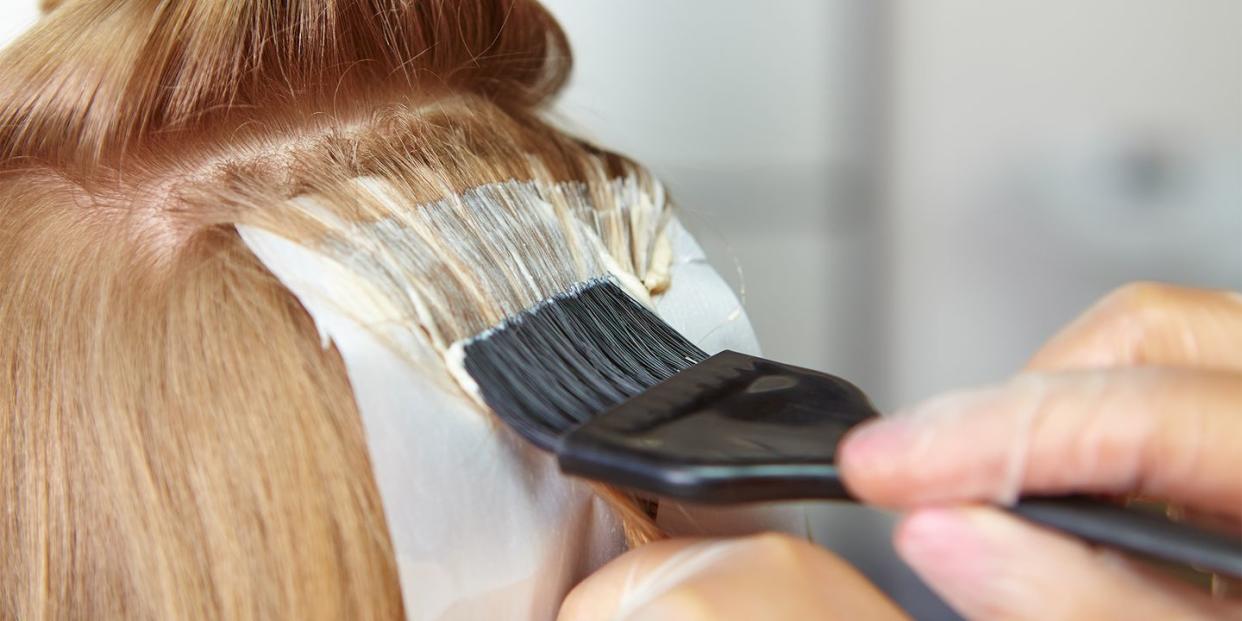Organic Hair Dye Is a Myth—But You Can Still Find Clean Hair Color

Just about every facet of your haircare routine can be clean and organic—except for the one you probably spend the most time, money, and energy on. We’re talking about hair dye, those oh-so tempting chemicals that promise the hair color of your dreams. Regarding semi-permanent and permanent hair color, the VP of Research and Development at John Paul Mitchell Systems and Color Chemist Valerie George says, “There is no such thing as organic.” So, does that mean it’s not clean, or safe? We turned to the experts to separate fact from fiction.
Sorry: Natural Hair Dye Doesn't Exist
At least, not in the traditional sense. “The only ‘natural’ hair dye that exists is based on henna, cassia, or indigo extracts. These can be blended together to create natural shades of brown, or a reddish color,” explains George.
But there is a reason why stylists often suggest avoiding henna, even if it’s one of the more natural options. Once you’ve applied it, it’s in there. “Keep in mind that if you want to dye your hair later, it may be difficult to go lighter in color. Henna is very hard to lift out of your hair later,” says Chris Appleton, a celebrity hairstylist whose clients have included Kim Kardashian West and Jennifer Lopez. “It should also be noted that hair will not lift with bleach easily after using henna, so you need to go a shade darker, rather than lighter.”
This weeks hair inspo 4 u ... BOUNCY 💪🏽
A post shared by Chris Appleton (@chrisappleton1) on Mar 6, 2020 at 7:18am PST
You can run a risk of facing henna’s dark side if you attempt the latter. “Henna, like all plant-based materials, contains heavy metals due to growing in soil. It’s very difficult to remove heavy metals when the henna is processed to make it ready for coloring the hair,” says George. “When the bleach comes in contact with the heavy metals from the henna, uncontrollable reactions can occur with high heat, which can burn the consumer or dissolve the hair.” Yikes.
But Why Isn’t Conventional Hair Dye Organic?
It’s one thing to understand that your hair dye is full of inorganic ingredients—it’s another thing to understand why it matters, and that it’s not a bad thing (because, let's not forget, water is also a chemical). “Conventional hair color needs four ingredients to work: oxidative dyes to color the hair, antioxidants to keep the dyes from reacting before they’re used, alkalizer like ammonia or MEA to swell the hair, and hydrogen peroxide. None of these are organic or natural,” says George. “The other ingredients in the color are to make the base—whether it’s a cream or a gel—but they don’t actually color the hair.”
Remember what “organic” actually means beyond its marketing appeal, too. “Organic is a term used to define a farming practice prior to cultivation of a plant,” she adds. “The dyes are also synthesized from petrochemical origin, so the term organic wouldn’t apply to anyone’s dyes.”
Why pick one color? 🌈 @hairbypaulaperalta
A post shared by Paul Mitchell (@paulmitchell) on May 3, 2020 at 11:53am PDT
Hair Dye Is Still Safe, Though
According to the Federal Food, Drug, and Cosmetic Act, color additives must be approved by the Food and Drug Administration (FDA) before they are used in cosmetic products, including hair dye. “Many more studies have been done on hair colorants than, let’s say, botanical extracts,” notes George. “Make sure you are routinely patch tested for allergies and you can rest assured knowing you’re safe.”
A post shared by Stephanie Brown (@stephaniebcolor) on Dec 20, 2019 at 8:52am PST
And You Can Find “Clean” Hair Dye
New York City master colorist at IGK salon Stephanie Brown says the two most common hair dye ingredients to try and avoid are ammonia and p-phenylenediamine (PPDA or pPD). She explains that the latter is found in most dark (brown, black) hair dyes, and has been known to cause severe—though rare—allergic reactions. The only way to know you're allergic to PPDA is to actually have a reaction, which is why a skin patch test 24 hours before slathering a dye all over your scalp is usually a great idea, especially if you've been prone to contact dermatitis or other skin conditions in the past.
“Hair dye can be made as clean as possible,” adds Appleton. “To me, clean hair dye is anything without ammonia in the formula, as well as being free from any harsh chemicals.”
Try Cruelty-Free & Vegan Hair Dyes
In addition to paying attention to ingredient lists, you can always opt for cruelty-free and vegan hair color. Brown lists Overtone and IGK as some of her favorite brands that don't test on animals. “The Revlon Total Color is plant- and hemp-seed-based dye that works great on hair,” says Appleton; the permanent hair color is vegan and made without ammonia, parabens, and silicones, as well.
So while fully organic conventional hair color may not exist—yet—you can still find suitable options for when the mood strikes. You just have to do your homework first.
You Might Also Like

